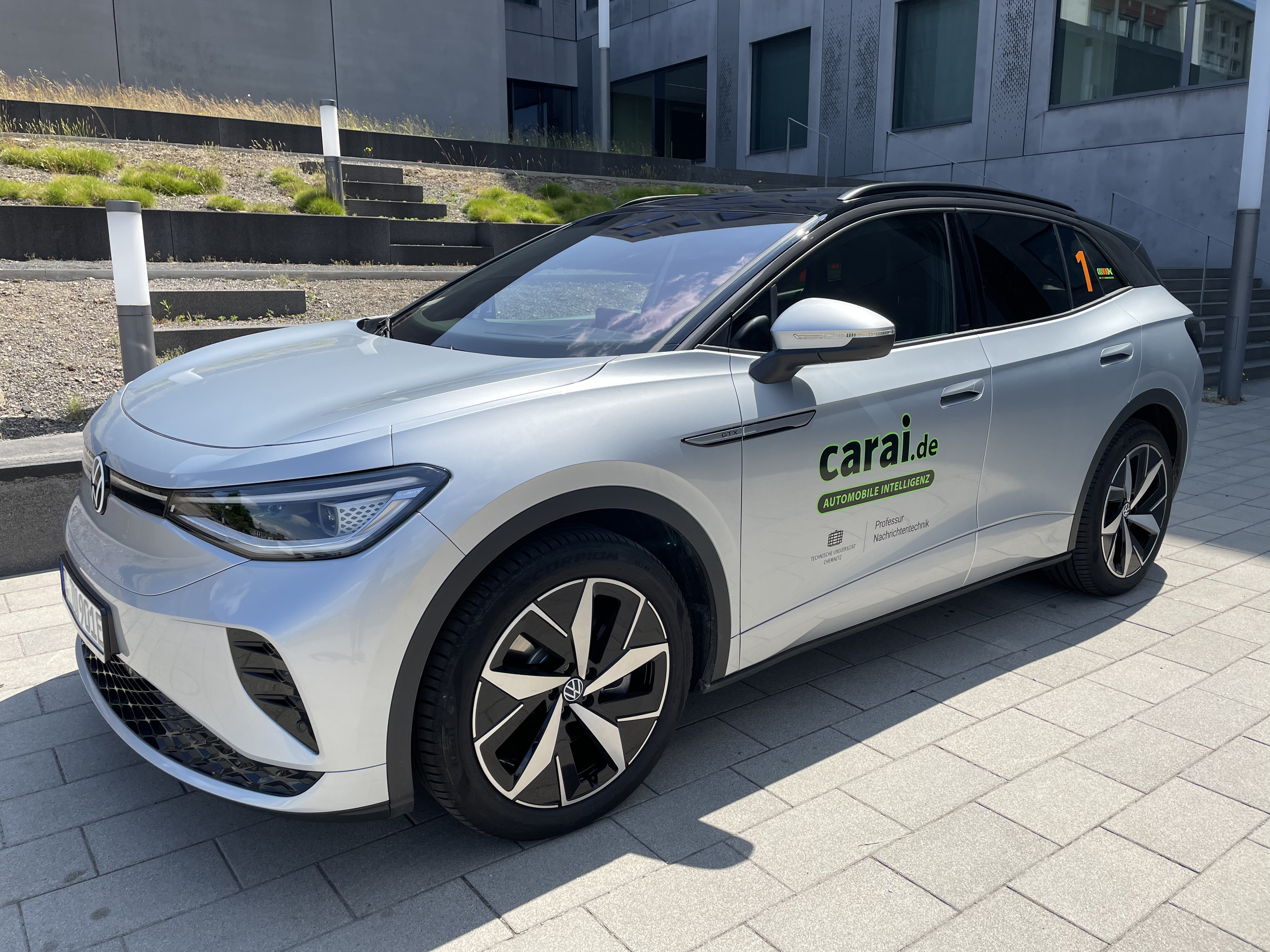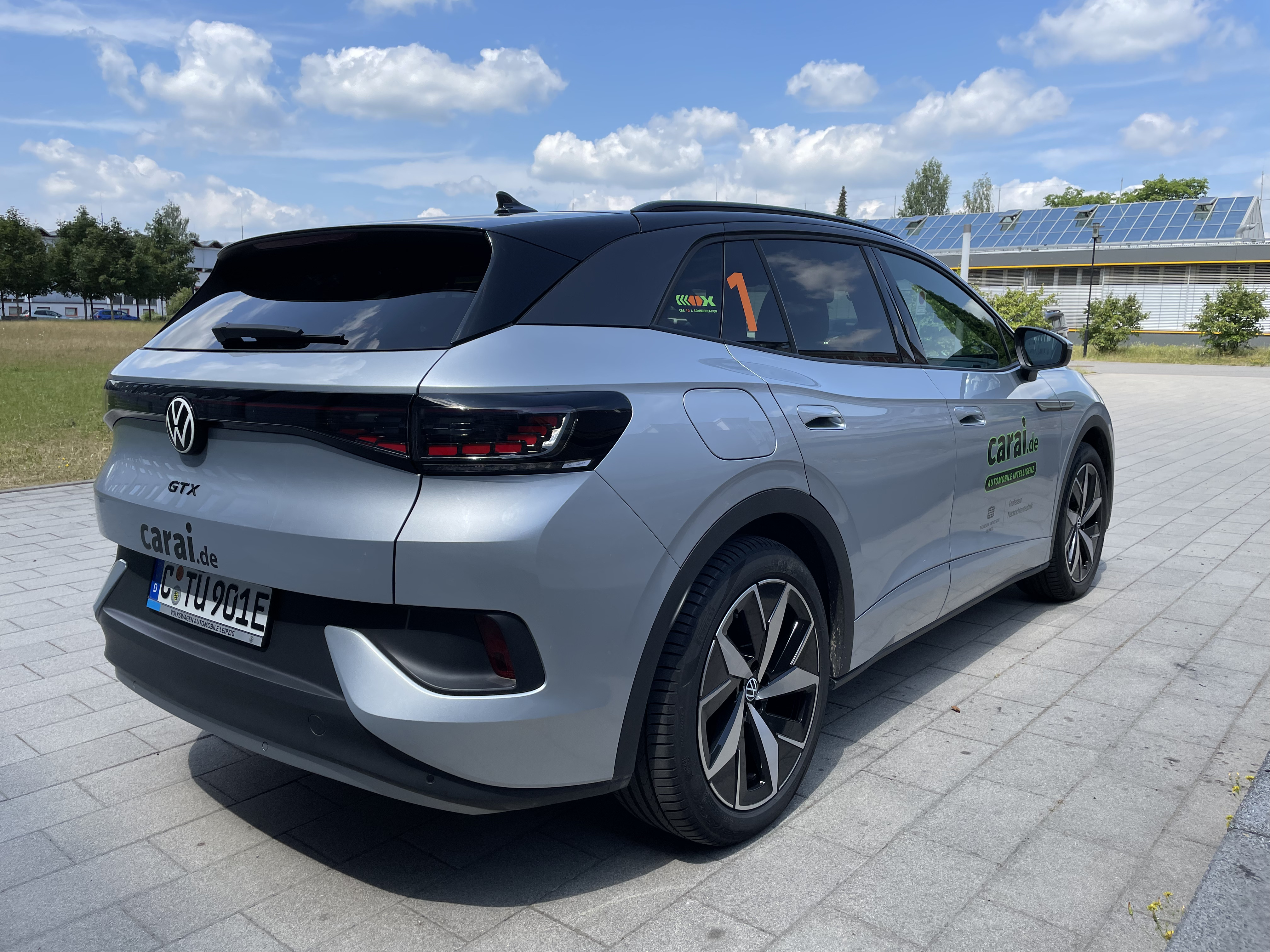Experimental Vehicle Carai 1 (VW ID.4 GTX)
The concept vehicles Carai are equipped with various sensors for vehicle environment recognition. The name Carai is a coined term from the English word for car and the initials A and I for "Automobile Intelligence." Within the scope of Forschungsprojekte , the Carai is used to investigate current and future applications of driver assistance systems.
In particular, the following functions are in the foreground.
Especially at night, during bad weather, and on rural roads, there is an increased risk of accidents. In particular, vulnerable road users such as pedestrians, cyclists, and motorcyclists need to be protected.
1. Protection of vulnerable road users
Using thermal imaging or near-infrared cameras, individuals can be detected in front of the vehicle in a timely manner. The sensor data is processed using appropriate image processing techniques. A lidar is used as a supporting sensor for distance measurement. The automotive industry has already implemented such person detection systems, such as the "Night Vision" system in BMW or the "Honda Intelligent Night Vision System". Additionally, similar person detection methods could find applications in the civilian security sector.
2. Car Detection
An important prerequisite for implementing safety functions in vehicles is the ability to detect other road users such as cars or trucks, as well as their position and direction of travel.
In Carai, this is achieved using various sensors, either individually or in fusion. In addition to radar sensors and lidar sensors, various camera systems are used (such as near-infrared cameras, far-infrared cameras, 3D cameras, stereo cameras, grayscale cameras, color cameras). The data is processed using image processing techniques and signal processing. This can be done either at the raw data level or based on preprocessed measurement data. Tracking methods and classification algorithms are also employed.
The function of vehicle detection has already been implemented in several applications, such as adaptive cruise control (ACC). The extended ACC function, known as Stop-and-Go, which is a driver assistance system for automatic stopping and restarting in traffic jams, can also be implemented using vehicle detection. The so-called collision mitigation function can be achieved as well. An example of such a collision-mitigating braking assistant is the "Collision Mitigation Brake System" by Honda.
3. Hazard Detection
In certain traffic situations, it is sufficient to be able to detect moving or stationary obstacles without the need to classify them. The focus is on the pure detection of obstacles and their velocity vectors. With the help of an appropriate driver assistance system, it can quickly be determined how large an obstacle is and whether braking is required, for example. This function of obstacle detection also allows for recognizing the available free space, such as during parking.
In Carai, this is implemented using lidar and radar sensors, as well as various camera systems. In addition to video, infrared, and 3D cameras, cost-effective ultrasonic technology is also utilized by vehicle manufacturers. The function of obstacle detection can be used for parking aids or construction site recognition. Pre-crash systems, as already employed by Daimler, are another potential application. Furthermore, future possibilities include their use in the field of collision mitigation.
4. Lane Detection
To be able to perceive the vehicle surroundings in detail, certain knowledge about the road is required: Where is the road located? How is it designed? How wide is the lane?
Such information about the road can be generated based on road markings or other features (such as surface characteristics). In Carai, this is achieved using lidar sensors and video cameras to detect markings and road edges. These pieces of information are utilized in estimation procedures (tracking) that estimate the lane trajectory over time, enabling predictions of possible changes in important parameters such as width or curvature.
This functionality finds practical application in lane-keeping systems like Lane Departure Warning or Lane Keeping. Honda, for instance, already employs an active lane-keeping assistant called the "Lane Keeping Assist System (LKAS)." Similar functions can also be implemented in adaptive cruise control systems (Adaptive Cruise Control (ACC) next generation) or lane change assist systems.
5. Localization
Localization can be used to generate information about the vehicle's position within the roadway. At a basic level, it can determine whether the vehicle is on a highway or a country road. Furthermore, the vehicle can position itself both laterally within a lane and longitudinally to obtain information such as the distance to the next exit.
The goal is to achieve centimeter-level localization, either with or without prior knowledge of the environment (e.g., through digital maps). In Carai, localization can be realized using camera systems and lidar sensors. Additionally, GPS/DGPS is used for coarse positioning, while fine localization in the centimeter range is achieved by recognizing landmarks (such as road markings, traffic signs, or traffic lights) in conjunction with digital maps.
This functionality can be utilized, for example, in map-based adaptive cruise control (ACC) or for location-based services such as providing traffic information specific to the vehicle's current position. Similar functions are also used in the EU-funded research project "SAFESPOT."
6. Communication
The exchange of information and data between road users and infrastructure significantly contributes to expanding one's perception of the vehicle environment and increasing traffic safety. This can be achieved through Car-to-Car communication or communication from the vehicle to any other road user, such as pedestrians (Car2X or V2X).
To implement this functionality, active communication units such as GSM modules, standard communication units (WLAN), or dedicated communication units (based on current C2C standards like 802.11p or IEEE 1609.3/4, WAVE) are used in Carai. These units can be used individually or fused with other sensors. Algorithmically, there is a general exchange of information via specific communication protocols, which can then be integrated into one's own perception of the environment.
Practical applications can be found in pedestrian protection, such as the "WATCH-OVER" project. Communication functions are also implemented in applications like the eCall system. Systems like BMW's "BMW Assist" enable automatic emergency calls from the vehicle when necessary.
7. interdisciplinary Research about Human-Machine-Interfaces
To effectively convey information from a driver assistance system to the driver, taking into account the driver's psychological and physiological characteristics, driver assistance systems are researched in an interdisciplinary manner within the I-FAS (Intelligent Driver Assistance Systems) framework. Within Carai, driver behavior is observed and recorded using various eye trackers. In principle, real-world applications can be found in every human-machine interface (HMI) within a vehicle.


